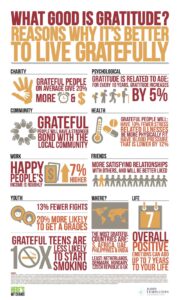The benefits of practicing gratitude are illustrated powerfully with this chart. Please take a look at the many benefits holistically – mentally, emotionally, physically, spiritually, and relationally.

The Templeton Foundation calls the practices of gratitude, “Gratitude Interventions.” Here are some of their suggestions from “The Science of Gratitude,” published May, 2018 and was written by Summer Allen, Ph.D. All of these practices have been studied extensively by teams of psychologists or social scientists.
- Counting Blessings – aka Gratitude journals -this involves writing down five things for which one is thankful. This is done daily or weekly.
- Three Good Things – this activity not only asks one to write down three good things but to also spend time identifying the cause of those good things.
- Mental Subtraction – imagine your life if a positive event had not occurred. The research shows that people who did this consistently reported improved mood stability.
- Gratitude letters and gratitude visits – The letter is written to someone who has impacted your life and you never really thanked them. If possible, hand deliver (post-COVID) and verbally thank them and then encourage them to read the letter.
- Death reflection – reflecting on one’s death, while seemingly “dark,” has been proven to be a way to increase one’s gratitude. It deepens one’s appreciation for life.
- Experiential consumption – this means spending money on experiences rather than things. This study found that people felt and expressed more gratitude following a purchase of an experience. i.e. concert tickets, trip to Italy, eating out, etc. In other words, creating memorable experiences creates more gratitude than buying material items such as clothing or jewelry.
Which one will you try this week?

